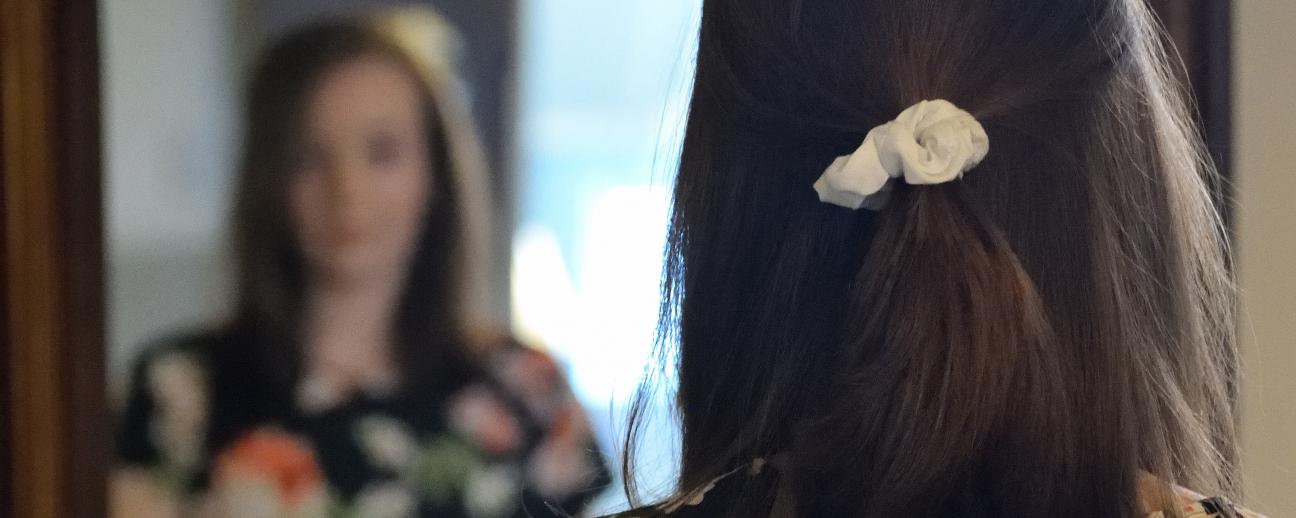Body dysmorphic disorder (BDD) is an anxiety disorder related to how a person views their body. A person with BDD believes that they have a flaw or defect in their body/ appearance. This perceived flaw may be very small, not visible to others, or imagined, but it causes them extreme distress. Someone with BDD has a distorted body image and thinks negatively about their appearance. They may believe that a body part is too small or too big, asymmetrical, or the wrong shape, colour, or size. Some people are aware that their beliefs are excessive, whereas others are convinced the perceived flaw is real and that others judge them negatively because of it.
The individual may think about this perceived flaw for hours each day, try to hide or fix it, repeatedly seek reassurance about their appearance, and spend excessive amounts of time grooming and checking their appearance in mirrors. These repetitive thoughts and behaviours impair their daily functioning. People with BDD also commonly struggle with low self-esteem and a fear of being judged by others. The anxiety, distress, and embarrassment about the perceived flaw can cause them to isolate, avoid social situations, and can lead to depression, substance abuse, and suicidal thoughts.
BDD is thought to be caused by a combination of psychological, biological, and environmental factors. Risk factors include a family history of BDD or anxiety disorders, a perfectionistic personality, experiencing abuse or trauma, being bullied or teased over childhood, and the pressure to meet societal beauty standards. BDD is thought to be related to an imbalance in levels of serotonin which is a chemical in the brain.
‘BDD with muscle dysmorphia’ is a subtype of BDD in which a person has a preoccupation with their muscles. They believe that they are too small or that they do not have enough muscle, and so they engage in excessive exercise, weight lifting, and dieting to build muscle. This condition affects significantly more males than females.
- Preoccupation with a perceived body flaw or defect - perceived flaws may be very small, not visible, or imagined.
- The perceived flaw causes extreme distress.
- Low self-esteem, negative thoughts about appearance.
- Anxiety and/or embarrassment about the perceived flaw leads to isolation and avoidance of social situations.
- Experience intrusive unwanted thoughts about perceived flaws for many hours each day.
- Engages in repetitive behaviours such as - behaviours to hide/ fix flaws, checking mirrors, excessive grooming, getting unnecessary cosmetic or medical procedures, seeking reassurance about appearance, comparing appearance to others.
- Belief that perceived flaw makes you ugly/ abnormal/ deformed.
- Belief that others notice this flaw and mock or judge you negatively because of it.
- Feeling depressed, anxious.
- Suicidal thoughts or behaviours.
Treatment for BDD usually involves a combination of psychological therapy (talk therapy) and medication.
Psychological Therapy:
Cognitive behavioural therapy (CBT) is a structured form of talk therapy which is effective in treating BDD. CBT for BDD aims to identify and challenge the negative perceptions and beliefs the individual has about their body/ appearance. There is a focus on identifying the negative thoughts and behaviours, and then working to change these beliefs. Goals in treatment include reducing thoughts and related behaviours, as well as addressing other issues such as low self-esteem, low mood, and social anxiety.
Medication:
Medication is most effective in treating BDD when prescribed in combination with talk therapy such as CBT. Antidepressant medications, such as selective serotonin reuptake inhibitors (SSRIs), may be prescribed. No medication is specifically designed to treat BDD, but SSRIs have been shown to be effective in helping to treat the depression, anxiety, and OCD like symptoms of BDD.
The Australian Centre for Clinical Intervention (CCI) has created an online workbook called ‘Building Body Acceptance'. This is designed for people with BDD and other body image problems. This workbook and the information sheet can help you learn about BDD, reduce repetitive behaviours, and become more accepting of your body.
The 'BDD Foundation UK' website is a great resource for learning about BDD. The website provides information on BDD, a self test to see if you meet criteria for BDD, links to books and videos, personal stories of those living with BDD, and advice for whānau and friends.
In this video we hear the story of a 17 year old boy with BDD. He shares his thoughts, feelings, and behaviours from the time of the initial signs of BDD, when his symptoms were at their worst, and through his treatment and recovery. His story emphasises the anxiety and distress that this disorder causes and the major disruption that BDD had on his life.
This excerpt from an Australian ABC Science documentary titled ‘Catalyst - Investigating Body Dysmorphia’ shows one woman’s experience with BDD and the research conducted by Prof. Susan Rossell and her lab on the disorder. Their research is using eye-tracking technology to understand if those with BDD look at bodies and faces differently than those without BDD.
‘The Broken Mirror’ was written by researcher and leading expert on BDD Dr. Katherine Phillips. In this book she combines her research and clinical experience to give a detailed overview of BDD and its treatment, as well as sharing interviews with clients to illustrate their experience with BDD. This is a handbook for those suffering with the condition, for clinicians, and for whānau and friends.
‘Beating BDD’ is a podcast hosted by journalist Clair Atherton in collaboration with the BDD foundation UK. Episodes feature interviews with specialists and those living with BDD. The aim of this podcast is to help those with BDD see that they are not alone and that recovery is possible.
